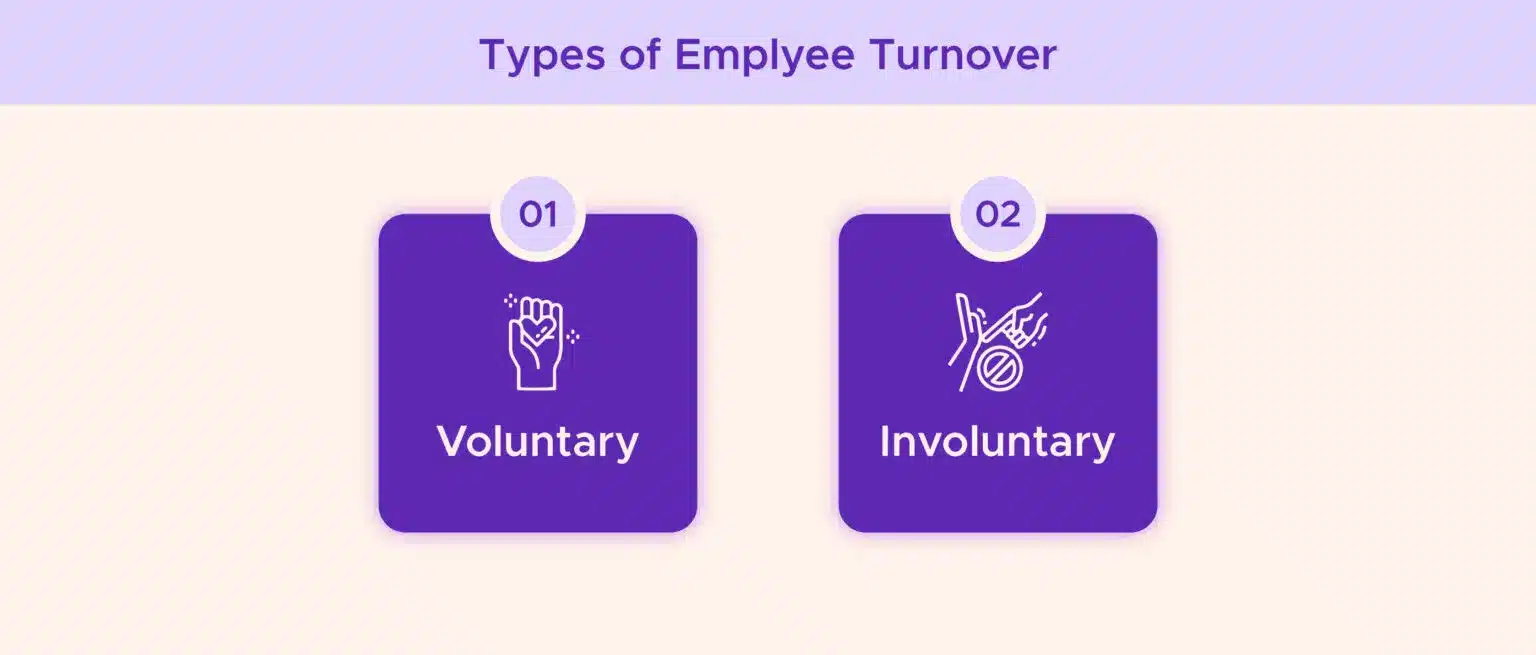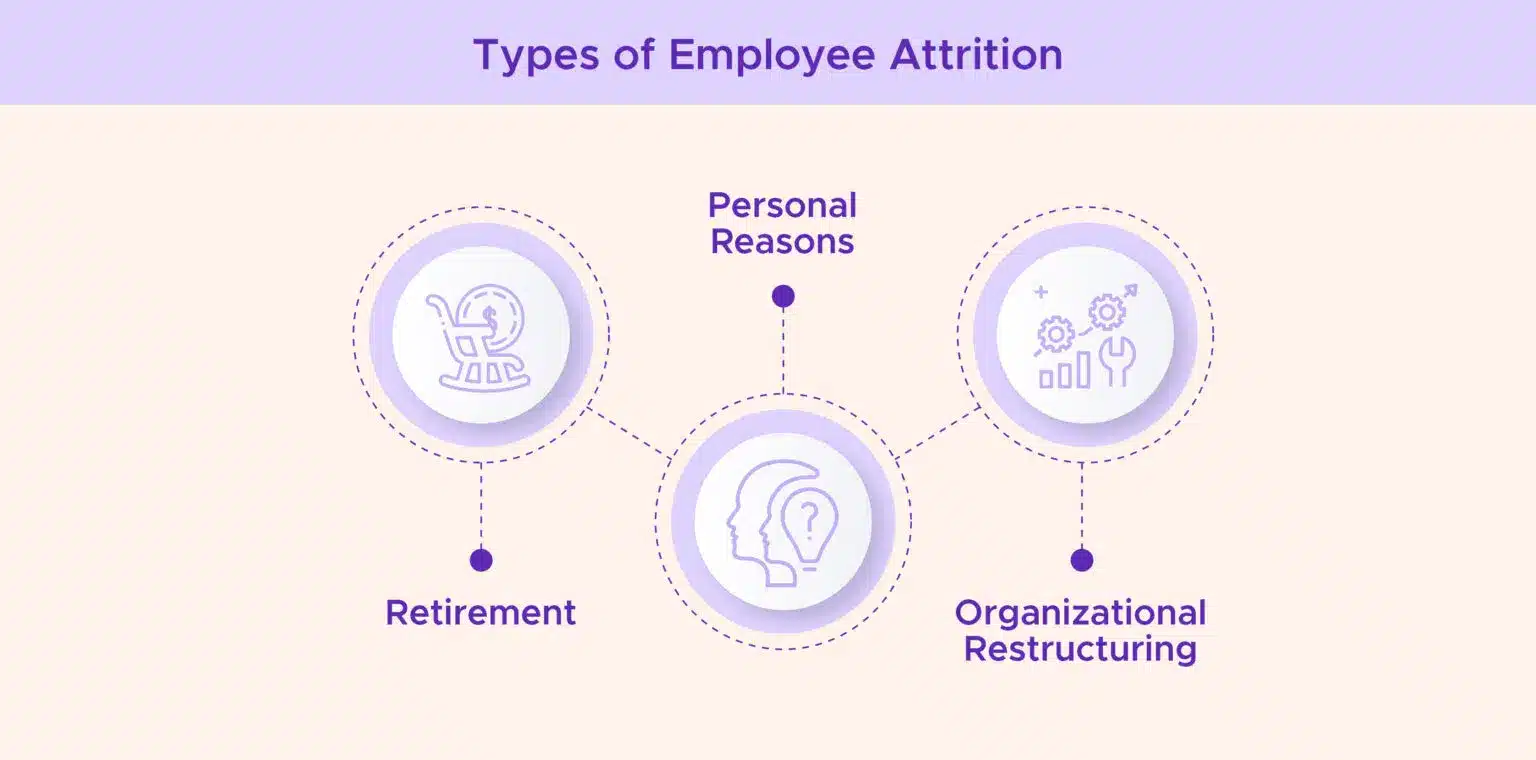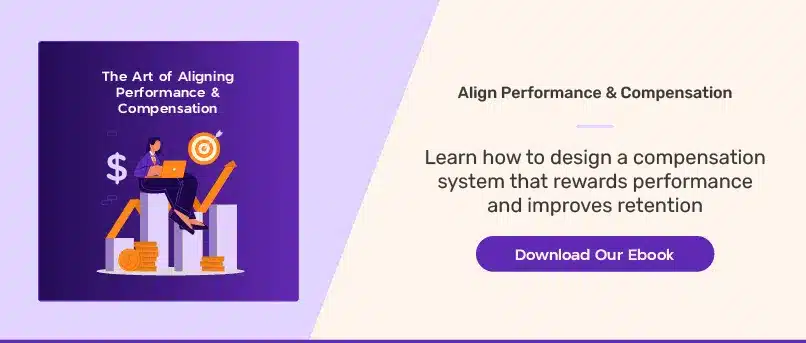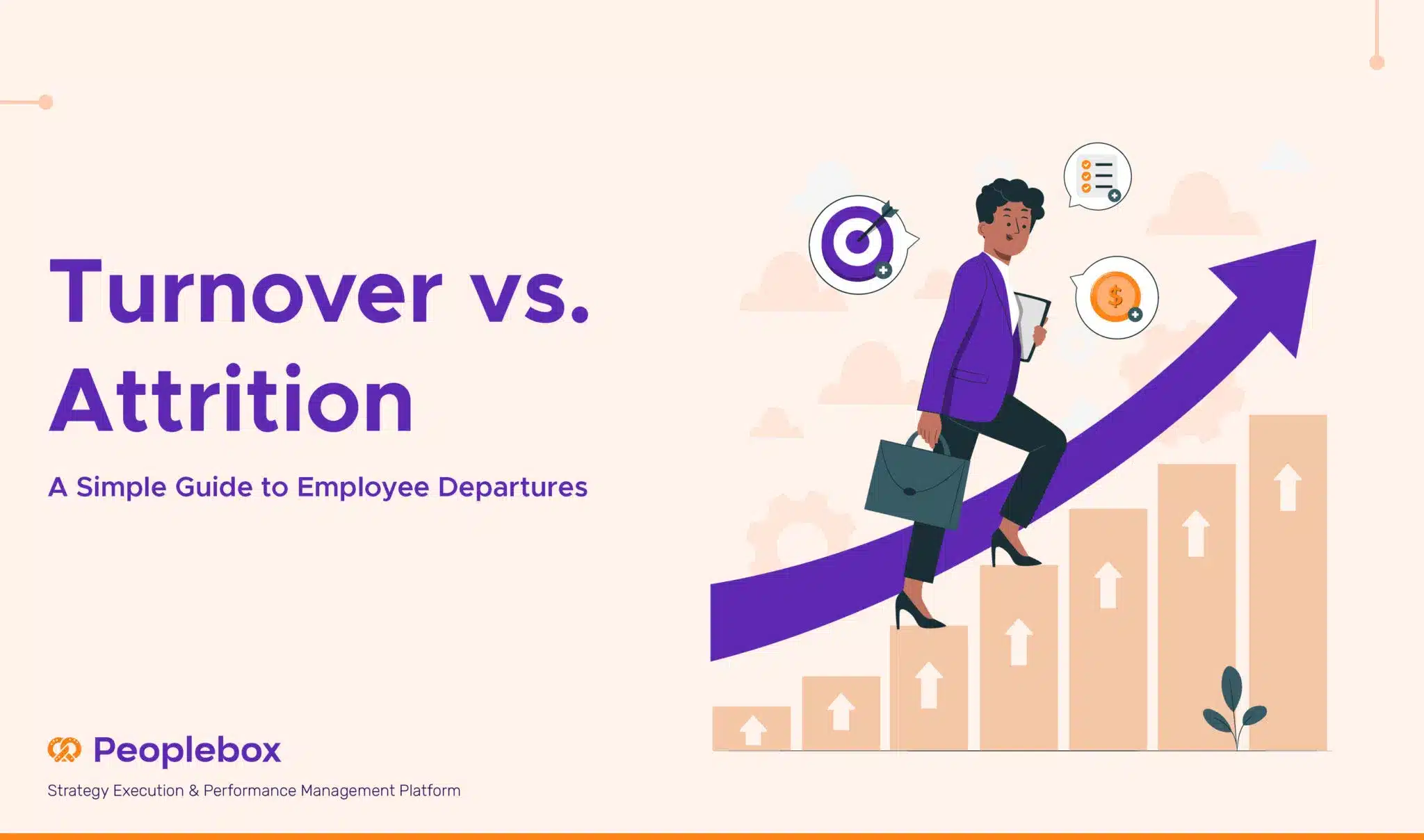Turnover and attrition are two critical human resources metrics that measure employee departures. While often used interchangeably, they have distinct meanings and implications for organizations. In this blog post, we will examine the differences between turnover vs attrition and explore their impact on organizational dynamics, employee retention strategies, and overall workplace stability. Let’s get started!

What is Employee Turnover?
Employee turnover refers to the number or percentage of employees who leave an organization over a certain period of time, usually a year. It includes both voluntary departures, such as resignations, and involuntary separations like terminations or layoffs.
What are the Types of Employee Turnover?

Employee turnover can be classified into two major types: voluntary and involuntary. Let’s differentiate between the two.
Voluntary Turnover
When an employee willingly decides to leave the organization, this is termed voluntary turnover.
Here are some examples:
- Resignations: Employees hand in their notice and move on to other companies. They could have found their dream job elsewhere or chose to work someplace else due to personal reasons. It could also be due to policies or events taking place in your organization that they do not agree with.
- Retirements: On reaching retirement age, an employee may have to quit the workforce.
- Relocation: This is when employees are changing their residence, and moving to a different city, making it physically impossible to work for you if you do not offer remote options for their role. Whether it’s for family reasons or a desire to explore new horizons, relocation results in voluntary turnover.
- Career changes: An employee might decide to pursue a different career path altogether.
Involuntary Turnover
Alternatively, involuntary turnover happens when the employer initiates separation. The following are cases of involuntary turnover:
- Terminations: This happens when an employee gets released due to low performance, misconduct, or violation of company policies.
- Layoffs: Sometimes, organizations have to cut down staff numbers due to economic challenges or specific measures being taken by them. As a result, individuals lose jobs involuntarily without any fault on their part.
- Job eliminations: Involuntary turnover may occur when a position is no longer needed or being phased out. The job of the employee becomes nonexistent.
While both forms of turnover have certain implications for an organization, voluntary turnover can be especially worrying. When employees opt to leave, it could be an indicator of deeper issues in the company’s culture, management, or compensation structure.
Calculating Turnover Rate
Here’s a simple formula to help you calculate the turnover rate for your organization:
Turnover Rate = (Number of employees who left ÷ Average number of employees) x 100
Let’s say a small software company called Acme Inc. has 50 employees at the beginning of the year. Over the course of the year:
- 5 employees resign to take jobs at other companies
- 2 employees are terminated for poor performance
- 3 employees are laid off due to budget cuts
- 4 new employees are hired to fill open positions
At the end of the year, Acme has 50 employees again (50 – 5 – 2 – 3 + 4 = 50).
To calculate the annual turnover rate:
- Total employees who left: 5 resignations + 2 terminations + 3 layoffs = 10
- Average number of employees: (50 + 50) / 2 = 50
- Turnover rate: (10 / 50) * 100 = 20%
So Acme had a 20% employee turnover rate for the year. This means 20% of their workforce left the company, which is on the higher side.
Interpreting High Turnover Rates
High employee turnover can indicate underlying organizational problems such as:
- Inadequate recruitment practices: Are you attracting suitable applicants?
- Restricted growth and development opportunities: Do workers have clear career paths and access to training?
- Noncompetitive compensation packages: How do your total rewards compare with industry benchmarks?
- Hostile work environment: Are there any problems with management, communication, or culture within the firm?
Poor hiring practices: If there is a high turnover of employees in your organization, it may be time to review your recruitment policy more keenly than ever before. Are you hiring the right candidates? Have you been clear about what it means to work there and what the company culture is like? Such poor practices will result in an employee-job mismatch making people leave early.
Lack of growth opportunities: Employees expect their careers to progress while they work with an organization. In case you fail to give them distinct career paths, training programs, or chances for promotion, employees will have to look for better opportunities elsewhere.
Negative work environment: High turnover might be triggered by a toxic work environment. This could result from poor management, the absence of communication channels, or even unhealthy competition among employees.
Uncompetitive compensation: If you aren’t keeping up with industry pay scales and benefits packages, you may be losing the employees who are aware of this. They’ll move on to competitors with better compensation.
To get a true picture of how your organization is performing check if your turnover rates meet industry standards. If your competitors are experiencing an average staff turnover rate of around 15%, while your turnover rates stand firm at 10%, you’re retaining your employees better.
What is Employee Attrition?
Employee attrition refers to the slow reduction of a company’s workforce through voluntary departures, retirements, or position eliminations. When it comes to attrition, the employees are not replaced — this is the key difference.
What are the Types of Employee Attrition?

There are several types of attrition. We can classify them according to the reasons for attrition.
Retirement: Experienced employees leave the workplace when they reach retirement age. If you have a high percentage of older employees in your workplace, you could experience higher attrition rates.
Personal reasons: Employees may resign because of shifting residences, family duties, or further studies. A common example would be an employee’s spouse securing a job in another city, prompting the employee to move out of your organization.
Organizational restructuring: Job cuts or departmental reorganization result in attrition. If you opt to merge two departments, some jobs may become redundant, leading to attrition.
Calculating Attrition Rate
You can calculate the attrition rate by using the following formula:
Attrition Rate = (Number of employees who left and were not replaced ÷ Average number of employees) x 100
Let’s consider a medium-sized marketing agency called Bright Ideas Inc. Throughout the year:
- 3 employees retire after long and successful careers
- 2 employees decide to leave for personal reasons
- 1 employee is laid off due to restructuring
- 2 positions are eliminated as part of a cost-saving measure
At the end of the year, Bright Ideas Inc. has not filled the vacant positions, resulting in a reduced workforce.
To calculate the annual employee attrition rate:
- Total employees who left without being replaced: 3 retirements + 2 voluntary attrition + 1 layoff + 2 position eliminations = 8
- Average number of employees: Consider the number of employees at the beginning and end of the year, then calculate the average.
- Employee attrition rate: (8 / average number of employees) * 100
Assuming Bright Ideas Inc. had an average of 60 employees during the year, the attrition rate would be calculated as (8 / 60) * 100 = 13.33%.
Therefore, Bright Ideas Inc. experienced a 13.33% employee attrition rate for the year, indicating a gradual reduction in their workforce due to various reasons without immediate replacements
Interpreting High Attrition Rates
High levels of attritions have different implications compared to high turnovers. When attrition rates are high, it can tell two different stories about your organization. Let’s explore both scenarios.
If you’re seeing a surge in attrition rates, it could be a sign that your workforce is aging. In this case, high attrition rates aren’t necessarily a bad thing — they’re a natural part of the workforce lifecycle. However, it does signal the need for proactive workforce planning. You’ll want to focus on:
- Succession planning: Identify key roles that will be impacted by retirements and start grooming potential successors.
- Knowledge transfer: Ensure that the valuable knowledge and expertise of retiring employees don’t walk out the door with them. Implement mentoring programs, documentation processes, and cross-training initiatives to preserve institutional knowledge.
- Recruitment strategies: Start thinking about how you’ll attract new talent to fill the gaps left by retiring employees. It’s time to get creative with your recruitment strategies and build a pipeline of qualified candidates.
On the other hand, high attrition rates could be a warning sign of deeper issues within your organization. If employees are leaving in droves, it might indicate a toxic workplace culture, poor management practices, or a lack of growth opportunities.
In this case, you’ll want to focus on:
- Employee feedback: Conduct exit interviews, engagement surveys, and focus groups to gather candid feedback from employees. Listen to their concerns and identify common themes or pain points. Employee engagement platforms like Peoplebox are a great way to make sure your employee voices are heard. Try it yourself!
- Management training: Invest in leadership development programs to equip your managers with the skills they need to create a positive work environment. Good managers can be the glue that holds teams together.
- Career development: Provide clear career paths and opportunities for growth within your organization. Show employees that they have a future with your company and that you’re invested in their development.
Turnover vs Attrition
| Attrition | Turnover |
| Gradual reduction of workforce | Rate at which employees leave and are replaced |
| Positions are not filled or replaced | Positions are typically filled or replaced |
| Can indicate an aging workforce or need for succession planning | Can indicate poor hiring practices, lack of growth opportunities, or negative work environment |
| Often a natural part of workforce lifecycle | Often a red flag for organizational issues |
| Focus on knowledge transfer and preserving institutional memory | Focus on identifying root causes and improving retention strategies |
| Proactive workforce planning is key | Reactive approach to address high turnover rates |
What is the Business Impact of Turnover and Attrition?
Increased Financial Costs
A study by SHRM estimates that the average cost-per-hire is just over $4000. With increased turnover and attrition, you’d have to shoulder increased expenses due to recruiting, hiring, and training replacement employees
You’ll also experience productivity losses during transition periods. New employees will take a while to work at expected levels of productivity, which can affect your company’s bottom line until they reach maximum productivity.
Knowledge and Skill Losses
Experienced employees carry valuable institutional knowledge, something that can rarely be taught and takes years to cultivate.
When these employees leave, it’s like losing a library of information. They take with them:
- Historical Context: Experienced employees often have a deep understanding of your organization’s history, culture, and evolution over time. They can provide valuable context and insights into why things are done a certain way.
- Relationship Networks: Long-tenured employees have often built strong relationships with clients, vendors, and colleagues across different departments. When they leave, those relationships can be disrupted or lost altogether.
- Tacit Knowledge: Some knowledge is difficult to articulate or document. It’s the kind of intuitive, experiential knowledge that experienced employees possess. When they leave, that knowledge goes with them.
The loss of institutional knowledge can have a ripple effect throughout your organization. It can lead to decreased efficiency, missed opportunities, and a loss of competitive advantage.
Employee Morale and Engagement
Lots of employees leaving will lead to morals being affected. The remaining employees may face additional workload, or simply miss lost team dynamics. If many people in management roles leave, remaining employees may be apprehensive of the new leaders who are coming in and struggle to adjust to new working styles. All this combined can slow down productivity.
When turnover or attrition is high, there is also a sense of instability that impacts employee engagement.
To mitigate these impacts identify what causes turnover at source or attrition then develop focused retention strategies.
Tip: Find out the reasons why people stay in your firm through stay interviews so that you can make improvements in your employee value proposition accordingly.
What are the Strategies for Managing Turnover and Attrition?
Here are a few strategies you can start implementing today to stay ahead of heightened turnover and attrition.
Conduct Thorough Exit Interviews
- Identify patterns and areas for improvement: For instance, common themes such as management problems or lack of chances for growth can be gathered from employee feedback.
- Gather candid feedback about the employee experience: Create a safe space where the departing employees can freely share their views without fear or favoritism.

Implement Comprehensive Onboarding and Training
- Equip new hires with the necessary tools and knowledge for success: Have a well-structured onboarding program that includes job-specific training as well as introductions to key stakeholders.
- Foster a sense of belonging and engagement from the outset: Give every new hire an ally and check in often to make the transition smooth.
Tip: Create a 30-60-90 day onboarding plan template that managers can personalize for each new employee.
Offer Competitive Compensation and Benefits
- Regularly review and adjust compensation to align with market rates: Perform annual salary surveys to ensure your compensation packages are competitive enough.
- Provide a comprehensive benefits package that supports employee well-being: Consider flexible work schedules, wellness activities, and generous paid leave policies along with traditional employee benefits like health insurance.
Tip: Undertake total rewards analysis to identify areas where there is a need for improvement as well as gaps noticed so far.

Provide Growth and Development Opportunities
- Invest in employee training and skill development: Combine on-the-job training, mentorship programs, and external learning opportunities to help your employees advance.
- Create clear career paths and advancement opportunities: Let employees develop personal plans for their advancement aligned with their career goals through working closely with them.
Tip: Install a learning management system that will help employees with tracking progress.
Foster a Positive Work Culture
- Promote open communication and collaboration: Ask for feedback from employees about their routines at work, and facilitate cross-functional communication between departments.
- Encourage work-life balance and employee recognition: Introduce flexible working hours plus reward schemes based on achievements made by employees.
Develop Succession Planning and Knowledge Transfer
- Identify key roles and potential successors: Conduct a skills gap analysis to identify critical positions and how well-equipped the employees in that position are to deal with their roles.
- Implement mentoring and cross-training programs to preserve institutional knowledge: Match experienced employees with newer team members to improve information transfer.
Tip: Develop a succession planning template that contains key roles, potential successors, and development action plans.
Leveraging Peoplebox for Effective People Management
If building a thriving workforce is your ultimate goal, Peoplebox is the answer. Peoplebox offers a comprehensive talent management platform to help you drive high employee retention and performance.
Set Ambitious Goals with OKRs: Establish clear Objectives and Key Results (OKRs) that cascade down from company-wide goals to individual team and employee levels, ensuring everyone is working towards a unified vision.
Foster Continuous Feedback: Move beyond annual reviews and embrace a culture of ongoing feedback. Peoplebox facilitates regular check-ins, performance conversations, and 360-degree feedback, fostering growth and development.
Track Progress and Analyze Data: Gain valuable insights into performance trends, employee engagement, and areas for improvement. Peoplebox’s robust analytics and reporting feature empower data-driven decision-making for a more strategic approach to people management.
The result? A more engaged and productive workforce, reduced turnover, and a significant boost to your bottom line.
Ready to unlock the full potential of your people? Book a demo now.








